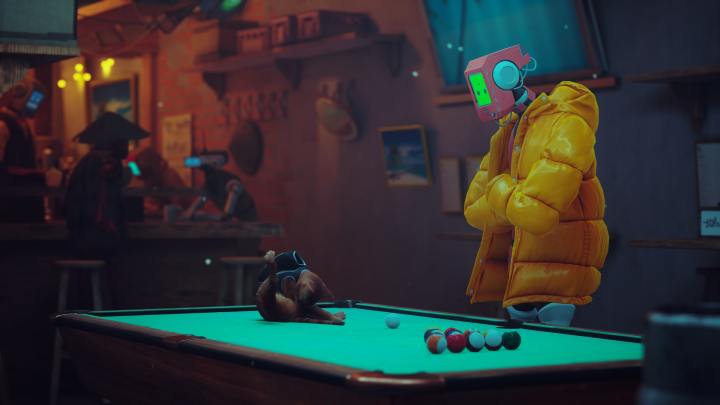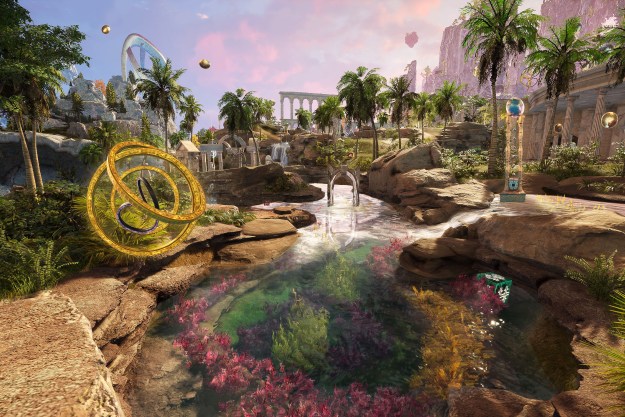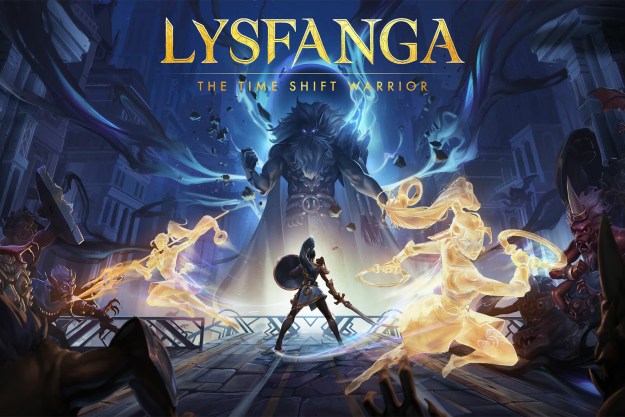When I woke up the morning before my hands-off preview of Stray, developer BlueTwelve Studios’ game about a feline hero wandering a city, I was immediately greeted by my own cat, Mirah. She hopped up onto my bed and curled up right on my chest, as has become one of her new habits in recent months. In the hour leading up to the preview, she’d run through her usual morning routine, like hopping up on the side of the tub when I finished showering and trying to lick the water. When I finally sat down at my desk and logged into the event, she slunk underneath my legs and fell asleep on my Wi-Fi router.
Cats can be absolute weirdos. Each one has their own set of quirks that can be puzzling, infuriating, or downright adorable. Stray looks to capture and embrace all those little ticks via an adventure game that’s cleverly built around some familiar behaviors. Based on the demo I saw, Stray looks like it’ll do for cats what Untitled Goose Game did for geese — just replace the honk button with a meow button.
Scratch and claw
In Stray, players control a precious orange cat who freely roams a futuristic city filled with robots. The slam-dunk premise was inspired by Hong Kong, a city that the game’s creators felt was a perfect playground for cats thanks to all of its nooks and crannies. That idea ballooned into a full-blown adventure game where a stray animal freely explores a city with the help of a drone friend that can translate robot speak and hold items.

A wide range of feline behaviors have been adapted into gameplay here, with some quirks proving to be useful for puzzles and exploration. Like any good (or bad) cat, Stray’s hero can knock things over whether they have a good reason to or not. In one scenario I saw, that proved quite useful. The cat knocks a paint can off a ledge, which smashes a glass ceiling below it. That allows the pesky critter to enter the previously closed building. Of course, it lands in the paint on the way down and leaves blue paw prints all over the carpet. Typical.
Naturally, the cat just has to scratch too. In one part of the demo, I saw it scratching the side of a sofa just as my own pet loves to do. While there’s no gameplay incentive to ruin a perfectly good couch (other than to experience the DualSense’s haptic feedback interpretation of it), scratching actually has its uses elsewhere. In one moment, I watched the cat scratch a building’s front door. When a robot swung it open, the critter bolted inside and began exploring.

Other systems aren’t exactly helpful, but they do replicate the cat experience accurately. In one moment, the cat passes by a robot laying down on a bench outside. It hops up onto its stomach and proceeds to snooze. Considering how my own morning started exactly the same way that day, it’s an accurate representation of the cat lifestyle.
It’s probably no surprise to learn that the game was made by cat lovers, which explains the attention to small details. The orange hero was loosely modeled on the creators’ cat, Murtough, who has visited the BlueTwelve Studios offices on multiple occasions. The office even has two cats of its own, who I presume are really pulling the strings behind the scenes.
On the prowl
The most intriguing design consideration comes from cats’ unique mobility. The animals are notably agile (unless you’re my cat, who scrambles up the side of my couch clinging on for dear life) and don’t tend to miss their mark when jumping. To recreate that, Stray’s approach to platforming is built around button presses instead of free-form movement. Anytime the cat can jump onto an object, an X button prompt appears on-screen. That ensures that the kitty won’t screw up an easy leap onto a radiator like my buffoonish angel would.

While there’s no combat to speak of, the movement does have some action implications. In one scene, I saw the cat running through a sewer at top speed as little swarming enemies chased it down. It’s a fast-paced chase scene that requires some quick button presses to escape. The cat can “die” as a result of failure, though it’ll respawn back safely (presumably, those nine lives are getting put to good use).
The city design is built with agility in mind too. The neon-drenched streets are filled with little nooks and crannies that only a cat could weave through. There’s a lot of verticality to the areas too, oddly calling Cyberpunk 2077’s Night City to mind. In one section of the demo, the stray finds itself in a slum-like area of the city that’s built around a towering pillar. I watch as it hops up from foothold to foothold looking for NPCs to talk to.

There’s a bit more to the game than platforming, but Stray looks to be keeping the experience minimal. Players will mostly prowl around the city talking to robots and scanning “memories” to unlock lore about the mysterious sci-fi setting. It doesn’t turn its feline hero into an action hero. Instead, it seems to be a calming atmosphere piece about seeing the ins and outs of a world through the eyes of the most curious critter imaginable.
With a story expected to span at least seven hours, Stray looks to deliver a long adventure rather than a quick gimmick. Based on the footage I’ve seen, I’m excited to step into its cat’s boots and become the creature making a mess for a change, rather than the one cleaning it up.
Stray is set to launch sometime this year on PS4, PS5, and PC.
Editors' Recommendations
- Lorelei and the Laser Eyes could be one of 2024’s best and boldest games
- Every summer 2023 gaming showcase: full schedule of live streams
- Everything announced at Annapurna Interactive Showcase 2023: Blade Runner, Stray on Xbox, and more
- Sorry Starfield, but Chants of Sennaar is now my most anticipated September game
- We played Tribeca Fest’s 2023 game selections and walked away amazed





